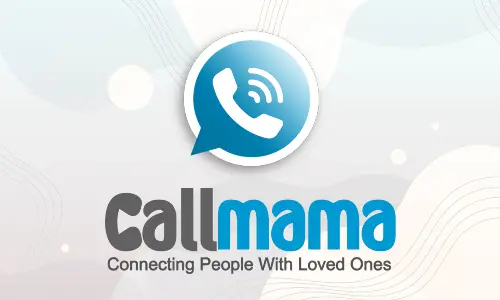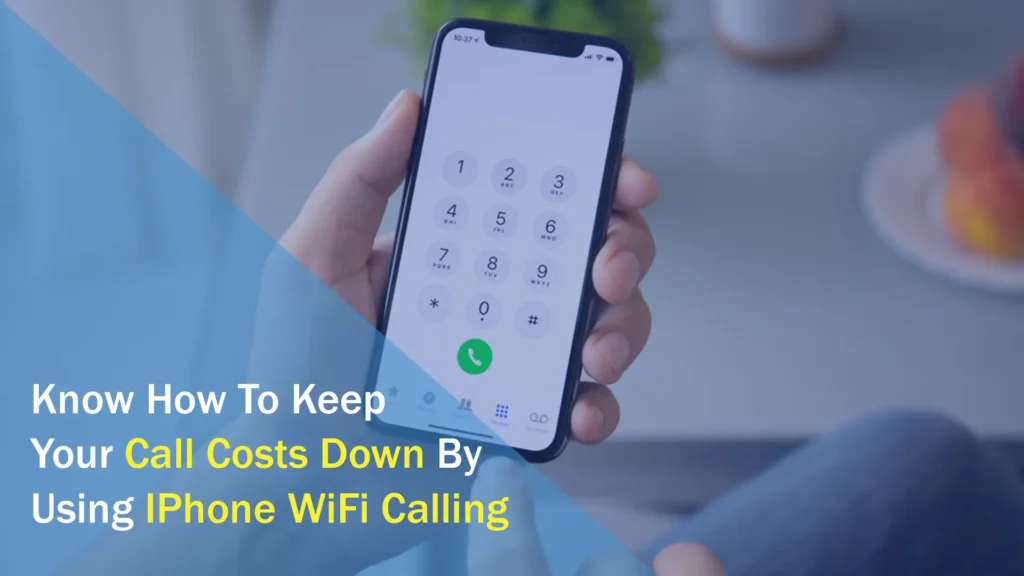Introduction
WiFi calling is a feature available on iPhones that allows you to make and receive calls and texts over a WiFi connection instead of through your cellular network. This can be extremely useful in many situations for iPhone WiFi calling.
For example, if you are in an area with poor cellular reception, like a basement or remote rural location, WiFi calling enables you to seamlessly make calls and send texts whenever you are connected to WiFi. This provides an alternative communication solution when you don’t have a cellular signal.
WiFi calling is also great for saving money, especially when travelling internationally. When travelling abroad, roaming charges for cellular networks can be very expensive. With WiFi calling enabled, you can connect to any available WiFi network and avoid all roaming fees that would normally be charged for cellular network usage overseas. This keeps your iPhone cellular plan costs down.
The setup process for WiFi calling on an iPhone is relatively simple. First, you need to make sure your iPhone software is updated to the latest iOS version that supports the feature. Then, under Settings, tap on Phone, then WiFi Calling, and toggle it on. As long as your cellular carrier supports WiFi calling, your iPhone will be ready to start making calls over WiFi.
When WiFi calling is enabled, your iPhone will automatically route calls and texts over WiFi whenever you are connected to a WiFi network. This provides a seamless experience, allowing you to transition smoothly between cellular and WiFi networks if you leave the WiFi area. WiFi networks do need to meet certain quality standards to support WiFi calling reliably.
There are a few key settings to manage for the WiFi calling experience. Under WiFi Calling Settings, you can enable options like ‘Prefer WiFi’, which will always prioritize WiFi calling when connected. You can also disable cellular network calling entirely in some situations. Be aware that excessive WiFi calling may reduce your cellular plan minutes more quickly.
Overall, WiFi calling is an invaluable feature for any iPhone user who deals with poor cellular coverage regularly or wants to reduce cellular costs. With a few taps, you can make crystal-clear calls over WiFi networks instead of spotty cellular connections. Just be sure to understand your carrier’s terms for WiFi calling to avoid any unintended charges.
A brief explanation of what WiFi calling is and its benefits iPhone WiFi calling
WiFi calling allows you to make and receive calls and texts over a WiFi network instead of using your iPhone’s cellular connection. This brings several major benefits that can improve your calling experience.
The most obvious advantage of WiFi calling is the ability to make calls and send texts in areas with poor or no cellular coverage. If you are in a building with thick walls that block cell signals, or even a basement, garage, or remote rural location, connecting to any WiFi network will enable communication through WiFi calling. This can provide a connection lifeline when no cellular signal is available.
WiFi calling also helps conserve your cellular plan data allowance. With WiFi calling enabled, all calls and texts made over WiFi will not count against your monthly cellular minutes or message allotments. This helps keep extracellular charges at bay. WiFi calling routes communication over WiFi data instead, which does not draw from your cellular plan.
One of the best perks of WiFi calling is eliminating costly roaming charges when travelling internationally. Calling or texting over cellular networks internationally can result in outrageous roaming fees. However, by enabling WiFi calling before travelling abroad, you can connect to any WiFi network and call or text normally without all those international roaming charges that can call Mama.
You may also experience improved call quality when using WiFi calling, depending on the WiFi network connection. This can provide a more reliable calling experience compared to struggling with a single bar of cellular coverage. The sound quality over a stable WiFi network can be much clearer than a weak cellular signal.
Setting up WiFi calling on an iPhone is quick and easy, requiring just a few settings adjustments. Just be sure to check with your carrier to see if they support WiFi calling on iPhones first. Once enabled, the transition between WiFi and cellular is seamless.
WiFi calling’s ability to provide connection reliability, cost savings, and higher call quality is an invaluable iPhone feature. In many situations, making calls over WiFi can vastly improve your overall communication experience and allow you to call Mama.
How WiFi Calling Works on iPhone
WiFi calling allows iPhones to route calls, texts, and other communications over a WiFi network instead of using their cellular connection. This works by using a technology called VoIP, or voice over IP.
Essentially, when WiFi calling is enabled, your iPhone will send your call or text messages over the internet via the WiFi network you are connected to. This works similarly to apps that offer VoIP calling through the internet, like FaceTime Audio or WhatsApp calls. However, with WiFi calling, the process is seamless and integrated directly into the standard iPhone calling and messaging apps.
To use WiFi calling on your iPhone, first, you need to make sure the feature is supported by your cellular carrier. Most major carriers now offer WiFi calling, but some smaller or regional carriers still do not support it. You also need to be running a recent version of iOS that includes WiFi calling capacity.
Once your carrier and iPhone software support WiFi calling, you simply need to enable it in the Settings menu. Go to Settings > Phone > WiFi Calling and toggle it on. You may need to register your emergency address to activate WiFi calling if prompted.
When WiFi calling is enabled, your iPhone will automatically route calls and texts over known WiFi networks you have connected to previously. If you move out of the WiFi range, it will transparently hand off the call to the cellular network.
To ensure good call quality, your iPhone will only use WiFi networks that meet certain minimum speed and connectivity standards. If the WiFi signal weakens during a call, your iPhone can seamlessly transfer the call back to cellular as needed.
From a user perspective, WiFi calling makes communication over WiFi networks feel like just another wireless signal. The process is automatic and integrated into the familiar Phone and Message apps. As long as you have WiFi calling enabled and are connected to a suitable WiFi network, you can call and text normally without any additional steps.
The result is added flexibility, expanded coverage, and potential cost savings from WiFi calling. With this feature, you are no longer limited to cellular signals for your iPhone’s calling and messaging needs.
Overview of enabling and using WiFi calling on iPhone
Enabling WiFi calling on your iPhone is a straightforward process that takes just a few steps. First, make sure your iPhone is updated to the latest iOS version that supports WiFi calling. Then, go to Settings > Phone > WiFi Calling and toggle it on. You may need to enter an emergency 911 address at this stage.
Once WiFi calling is enabled, your iPhone will automatically route calls over known WiFi networks whenever you are connected. You can select the ‘WiFi Preferred’ option to always prioritize WiFi networks for calling when available.
When on a call, your iPhone will seamlessly hand off between WiFi and cellular connections as needed if you move out of the WiFi range. This provides a smooth calling experience. Do keep in mind that excessive WiFi calling can reduce cellular plan minutes faster.
You can disable cellular calling entirely in Settings while on WiFi to avoid any cellular charges. This is especially helpful when travelling internationally to eliminate costly roaming fees. Just connect to local WiFi abroad and call Mama back home over WiFi alone.
The iPhone Calling and Messages apps work the same when using WiFi networks instead of cellular. So making calls or sending texts over WiFi is intuitive and familiar. With just a few taps, you can enable WiFi calling and enjoy expanded connectivity.
Requirements for using WiFi calling on iPhone (iOS version, carrier support, etc.)
To use WiFi calling, you first need an iPhone model that supports the feature. In general, the iPhone 5c and newer models work with WiFi calling. You also need to be running iOS 13 or later, as older iOS versions do not have the capability built-in.
The most important requirement is having a cellular carrier that supports WiFi calling on iPhones. Major carriers like AT&T, T-Mobile, Verizon, and Sprint allow WiFi calling, but some smaller regional carriers may not. Check with your carrier first.
When enabling WiFi calling for the first time, you may need to enter a valid emergency 911 address for your location. This ensures the proper routing of emergency calls made over WiFi.
For optimal WiFi calling connectivity, use a stable, high-speed internet connection. Slow or overloaded public WiFi networks can result in lower call quality. Connect your iPhone to a 5GHz band if available for clearer calling.
While travelling abroad, be sure to disable cellular calling and enable WiFi calling alone to avoid expensive roaming fees. Connect to a local WiFi network overseas to call Mama back home over WiFi rather than cellular roaming, which can charge Mama.
As long as your iPhone model, iOS version, and carrier all support WiFi calling, you can easily enable the feature and seamlessly make calls over WiFi for expanded coverage and potential cost savings.
Using WiFi Calling on iPhone
Enabling and using WiFi calling on an iPhone is a straightforward process that can expand your calling coverage and potentially save on cellular costs. Here is a step-by-step overview of using this valuable feature:
First, ensure your iPhone supports WiFi calling. In general, the iPhone 5c and newer models have the capability built-in. You also need to be running iOS 13 or later. Next, contact your cellular carrier to verify they support WiFi calling on iPhones. Major carriers like Verizon, AT&T, and T-Mobile accommodate WiFi calling, but some smaller carriers still do not.
Once you’ve confirmed your hardware and carrier support for WiFi calling, go to Settings > Phone > WiFi Calling and toggle it on. You may be prompted to enter a valid emergency 911 address at this stage. Read any terms and conditions carefully before enabling the feature.
With WiFi calling enabled, your iPhone will now route calls and texts over known WiFi networks whenever you are connected. To always prioritize WiFi networks, go to Settings > WiFi Calling and enable the “Prefer WiFi” option. This ensures calls will use WiFi instead of cellular when available.
Test WiFi calling by placing a call with your iPhone connected to a WiFi network. The process should work seamlessly, with no extra steps required in the phone app interface. Check for any issues with call quality over WiFi and troubleshoot your internet connection if needed.
When moving outside the WiFi range during a call made over WiFi, your iPhone should automatically hand off the call to the cellular network without disruption. This provides a smooth calling experience as you transition between WiFi and cellular coverage.
If travelling abroad, consider disabling cellular calling entirely and using WiFi calling alone to avoid expensive international roaming fees. Connect to any local WiFi network overseas and call Mama in the US over WiFi rather than costly cellular roaming that will cause Mama a heart attack when she sees the charges.
With some trial and error, you can optimize your WiFi calling experience for each network you use regularly. Consistent WiFi calling can reduce reliance on cellular networks and minimize monthly charges. Just be aware of any limit on WiFi calling minutes enforced by your cellular carrier to avoid unexpected overages.
A step-by-step guide to turning on WiFi calling and choosing preferences
To start using WiFi calling, go to Settings > Phone > WiFi Calling and toggle it on. You may need to enter a valid 911 emergency address at this stage.
Next, you can customize your WiFi calling preferences. Go back to the WiFi Calling settings and choose the “WiFi Preferred” option to have your iPhone always prioritize WiFi calling when a WiFi network is available.
You can also select the “Prefer Cellular” option to default back to the cellular network for calling in most cases. This may help conserve cellular plan minutes, but call quality may suffer if the cellular connection is poor.
For international travel, consider turning off the “Cellular Calls” option while on WiFi to prevent any roaming charges. With cellular calls disabled, you can call Mama in the US for free over local WiFi networks abroad rather than pay astronomical roaming fees.
Test WiFi calling by placing a call with your iPhone connected to WiFi. Make adjustments in the WiFi calling settings as needed to optimize connectivity and call quality. With a few taps, you can customize your WiFi calling experience.
Tips for getting the best connection and quality
- Connect to a 5GHz WiFi network instead of 2.4GHz if available. The 5GHz band typically provides faster speeds and less interference for clearer voice calls.
- If using a public WiFi network, try to connect closer to the router or access point for the strongest signal. Weak signals further from the router can degrade call quality.
- Limit active WiFi usage from other devices when on a WiFi call. Streaming video and downloading on the same network can disrupt your call.
- Disable auto-connect for any low-quality or unreliable WiFi networks in your saved list. Don’t allow your iPhone to connect to these by default for calls.
- Turn off WiFi Assist, which automatically shifts to cellular when your WiFi signal is poor. This defeats the purpose of WiFi calling.
- Try resetting network settings if you experience persistent WiFi calling issues on certain networks. This clears out any problematic configurations.
- When at home, optimize the placement of your WiFi router for the best coverage if WiFi calling performance is sub-par.
- If all else fails, politely ask others in your household to limit bandwidth-intensive internet use when you are on a WiFi call.
Following these tips will help provide the most stable connection and best audio quality when relying on WiFi networks for your iPhone calling needs.
Troubleshooting common issues
If WiFi calling is not working at all, first ensure the feature is properly enabled in your settings. Toggle WiFi calling off and on again if needed to reset the configuration. Also, verify that your carrier supports WiFi calling on iPhones.
Choppy audio or disconnections during WiFi calls likely indicate an unstable internet connection. Try moving closer to your WiFi router or access point and connecting to the 5GHz band if available for better performance. Limit other device usage on the same network.
Frequently dropping calls could mean your WiFi network is too slow and doesn’t meet your carrier’s requirements for WiFi calling. Test your connection speed and upgrade your internet plan if needed.
No handoff from WiFi to cellular could mean a weak cellular signal. Move to an area with better cell reception and toggle aeroplane mode on/off to force a handoff. Disable WiFi calling preferences like “Prefer WiFi.”.
If call quality is better on cellular compared to WiFi, your WiFi network may be overloaded or too slow. Optimize your WiFi environment by reducing congestion and connecting wired devices when possible.
Persistent issues may require resetting network settings on your iPhone or even a software update if it is on an outdated iOS version. Contact your carrier for WiFi calling support if needed.
WiFi Calling Features and Settings
- WiFi Preferred: This option always prioritizes WiFi calling over cellular when connected to a WiFi network. It is useful for reducing cellular plan usage.
- Prefer Cellular: Default back to the cellular network for most calls and texts, even when WiFi is available. Help conserve WiFi calling minutes.
- Cellular Calls: Disable this while on WiFi to block cellular calls and texts completely. Prevent roaming charges when travelling internationally.
- Handoff: This transitions active calls seamlessly from WiFi to cellular and vice versa as you move in and out of WiFi coverage. Provides a smooth call experience.
- Status Indicators: Status bar icons indicate whether a call is over WiFi or cellular. Manage networks accordingly.
- WiFi Notification: This alerts you when opening apps if the current WiFi network lacks connectivity for optimal WiFi calling.
- Emergency Address: Registers your location for accurate emergency service dispatch when WiFi is called. Keep this updated.
- Network Settings Reset: Clears all network configurations to troubleshoot WiFi calling problems. Resets everything to factory default.
- Carrier-Specific Features: Additional custom features may be available from your specific cellular carrier. Check for any value-added capabilities.
Adjust these settings appropriately for your usage needs and network priorities to customize WiFi calling on your iPhone.
Explain key settings like WiFi Preferred, disabling cellular, etc.
WiFi Preferred: Enabling this in your WiFi calling settings will make your iPhone always prioritize WiFi calling over cellular when connected to a WiFi network. This helps reduce cellular plan usage.
Prefer Cellular: This setting does the opposite and defaults back to the cellular network even when WiFi is available. It is useful for conserving WiFi calling minutes, which may be limited.
Cellular Calls: You can disable cellular calling entirely here while on WiFi. This prevents any roaming charges if travelling overseas. Just connect to local WiFi abroad and call for free over WiFi.
Handoff: This allows your iPhone to seamlessly transition active calls between WiFi and cellular as you move in and out of WiFi coverage. Provides a smooth calling experience.
Emergency Address: Your registered emergency address ensures proper routing of 911 calls over WiFi. Keep this updated if you move locations.
Network Reset: This resets all network settings to the default factory condition. It is useful for troubleshooting persistent WiFi calling problems.
These key WiFi calling settings allow you to customize WiFi versus cellular usage for calling on your iPhone based on your priorities, like reducing costs or maximizing quality. Adjust them appropriately for your needs.
Describe features like seamless handoff between WiFi and cellular
One of the most convenient features of WiFi calling is the ability to seamlessly transition active calls between WiFi and cellular connections. This handoff feature provides a smooth, uninterrupted calling experience.
When you are on a WiFi call and move out of the WiFi range, your iPhone will automatically hand off the call to your available cellular network. This transition is designed to be transparent and occur without any disruption to the active call.
Similarly, if you are on a cellular network call and enter a WiFi range with WiFi calling enabled, the call will quietly switch over to the WiFi connection without dropping.
This handoff capability ensures your iPhone calling remains persistent regardless of moving in and out of WiFi coverage areas. As long as a cellular signal is also available, the call should never be lost.
Seamless handoff applies to both outgoing and incoming calls. As long as the call was initiated with WiFi calling, your iPhone will maintain the call by shifting between WiFi and cellular as needed when signal strengths change.
Some key settings, like disabling cellular calling, can impact handoff behaviour. But in general, this feature provides smooth and continuous iPhone calling when using WiFi networks for voice calls and cellular as a fallback.
Benefits of WiFi Calling on iPhone
Reduce Cellular Data Usage
One of the biggest advantages of WiFi calling is reducing cellular data consumption from your monthly plan allowance. With WiFi calling enabled, any calls or texts made over a WiFi network will not count against your allotted cellular minutes or messages.
This helps conserve your cellular data for when you need it on the go and aren’t connected to WiFi. By making calls over WiFi whenever available, you can significantly cut down on cellular plan usage and avoid costly overage charges if you exceed limits. For those with limited data plans, WiFi calling is an invaluable tool to extend cellular data availability.
Make Calls in Poor Service Areas
WiFi calling also enables you to make and receive calls in locations where cellular coverage is weak or completely unavailable. For example, if you have a basement apartment or office with thick concrete walls that block all cellular signals, WiFi calling allows you to seamlessly make calls as long as you are connected to the internet.
This effectively provides a calling solution in dead zones where cellular networks cannot reach. Similarly, calling from remote rural areas with no cellular towers nearby is enabled by connecting to any available WiFi network. WiFi calling can be a communications lifeline whenever you lack a cellular signal.
Lower Costs when Traveling Internationally
One of the most appealing benefits of WiFi calling is eliminating the excessive roaming charges associated with international travel. When travelling abroad, roaming onto foreign cellular networks often incurs astronomical per-minute fees, especially when calling back to the US.
However, by enabling WiFi calling before leaving the country, you can connect to any local WiFi network overseas and call or text normally without racking up all those international roaming charges. This allows you to easily call family back home on WiFi without costing an arm and a leg. WiFi calling brings calling freedom abroad.
Better Call Quality
WiFi calling can sometimes provide better call quality compared to spotty cellular connections, depending on the WiFi network. A strong, stable WiFi signal enables clearer voice calling versus struggling with a single-bar cellular connection that is prone to static and choppiness.
Of course, this depends on the speed and congestion levels of the specific WiFi network being used. But in optimal WiFi conditions, WiFi calling can mean more reliable call quality and performance compared to weak cellular coverage.
In summary, WiFi calling brings immense benefits like stretching cellular data limits, expanding coverage zones, reducing international costs, and boosting call quality. For any iPhone user who relies heavily on cellular data or travels frequently, WiFi calling can be a very valuable feature to take advantage of.
Conclusion
WiFi calling is an extremely useful feature available on the iPhone that enables making calls and sending texts over WiFi networks instead of cellular connections.
The benefits of WiFi calling include expanding your coverage zones into areas with poor or no cellular signal, conserving your monthly cellular data allowance by using WiFi data for calling, significantly reducing international roaming charges when travelling abroad, and sometimes improving call quality compared to marginal cellular connections.
Enabling WiFi calling on your iPhone is a quick and simple process, requiring just a few settings adjustments as long as your iPhone model, operating system, and cellular carrier support the feature. Once enabled, using WiFi calling is seamless, with automatic hand-off between WiFi and cellular connections as you move in and out of WiFi coverage.
With WiFi calling providing advantages like cost savings, flexibility, expanded coverage, and better call performance, it has become an indispensable communication feature for many iPhone users who rely heavily on cellular network access. If you deal with dead zones or travel frequently, be sure to take advantage of WiFi calling on your iPhone.











